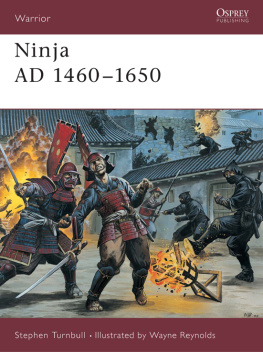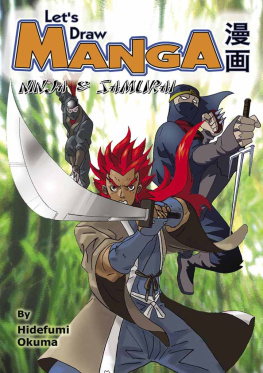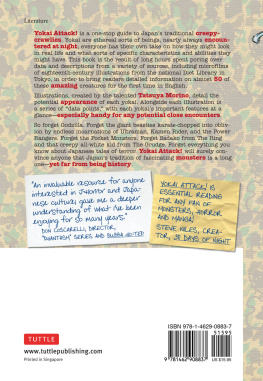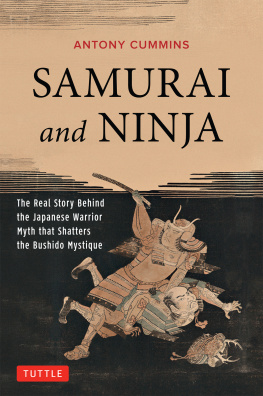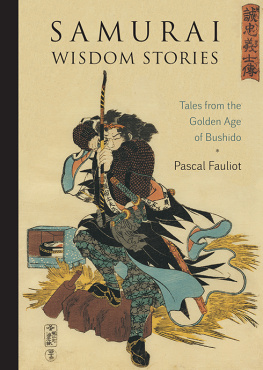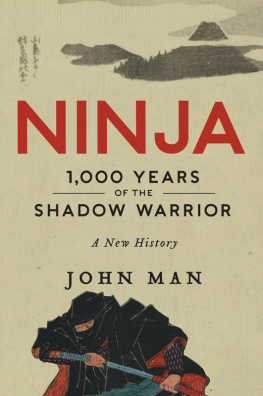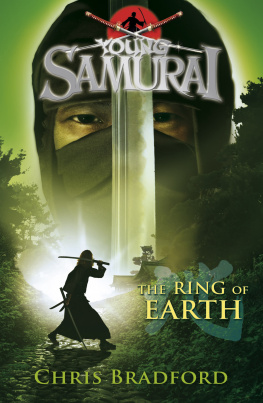Yoda Hiroko - Ninja Attack!: True Tales of Assassins, Samurai, and Outlaws
Here you can read online Yoda Hiroko - Ninja Attack!: True Tales of Assassins, Samurai, and Outlaws full text of the book (entire story) in english for free. Download pdf and epub, get meaning, cover and reviews about this ebook. year: 2013, publisher: Tuttle Publishing, genre: Detective and thriller. Description of the work, (preface) as well as reviews are available. Best literature library LitArk.com created for fans of good reading and offers a wide selection of genres:
Romance novel
Science fiction
Adventure
Detective
Science
History
Home and family
Prose
Art
Politics
Computer
Non-fiction
Religion
Business
Children
Humor
Choose a favorite category and find really read worthwhile books. Enjoy immersion in the world of imagination, feel the emotions of the characters or learn something new for yourself, make an fascinating discovery.
- Book:Ninja Attack!: True Tales of Assassins, Samurai, and Outlaws
- Author:
- Publisher:Tuttle Publishing
- Genre:
- Year:2013
- Rating:3 / 5
- Favourites:Add to favourites
- Your mark:
- 60
- 1
- 2
- 3
- 4
- 5
Ninja Attack!: True Tales of Assassins, Samurai, and Outlaws: summary, description and annotation
We offer to read an annotation, description, summary or preface (depends on what the author of the book "Ninja Attack!: True Tales of Assassins, Samurai, and Outlaws" wrote himself). If you haven't found the necessary information about the book — write in the comments, we will try to find it.
Yoda Hiroko: author's other books
Who wrote Ninja Attack!: True Tales of Assassins, Samurai, and Outlaws? Find out the surname, the name of the author of the book and a list of all author's works by series.
Ninja Attack!: True Tales of Assassins, Samurai, and Outlaws — read online for free the complete book (whole text) full work
Below is the text of the book, divided by pages. System saving the place of the last page read, allows you to conveniently read the book "Ninja Attack!: True Tales of Assassins, Samurai, and Outlaws" online for free, without having to search again every time where you left off. Put a bookmark, and you can go to the page where you finished reading at any time.
Font size:
Interval:
Bookmark:
Trivia
A NOT-SO-CLEVER RAPTOR?
Although Katoh is a historical figure, his tale reads like a fable for young ninja. The moral of the story is that it can be detrimental to reveal too much of ones abilities--particularly if they are of the sort that involve sneaking around and killing people. As the old Japanese saying goes, A clever hawk hides its talons.
ITS A DOGGY DOG WORLD
The art of ninjutsu includes a variety of methods for handling guard dogs. Collectively referred to as Ouken no Jutsu , literally Techniques for Dog Encounters, they include:
Goken no ho Bringing a dog of the opposite sex along, distracting the guard dog with carnal attention.
Inu kuguri no ho Based on extensive study of canine behavior, this involves exploiting knowledge of dog instincts and habits to avoid disturbing them.
Gukenjutsu For situations where time is not of the essence, this technique involves sneaking up to a guard dog again and again with treats, getting it used to your scent and appearance before a mission.
One of Katohs fatal mistakes was failing to exploit any of these techniques before killing Kenshins beloved dog.
So we have a record on both sides of bread being carried away. It appears the Americans might well have given Sawamura, who was conceivably assigned inconspicuously to the boarding party, the items he took back to his masters. This certainly makes more sense than his swimming, knife clenched in teeth, from shore and then somehow boarding the heavily armed and constantly guarded war-frigates without anyone noticing. And unromantic though it may be, it fits perfectly with the ninja modus operandi of always blending in. What better place to hide than among the members of an envoy with permission to come aboard?
In reality, Sawamuras role was probably closer to that of a secretary asked to keep his eyes and ears open during a critical meeting than of an Edo-era James Bond. Yet it is also a perfect illustration of just how times had changed for the ninja. Although feared as shadow warriors during the Age of Warring States some two hundred and fifty years earlier, ensuing centuries of relative peace essentially robbed them of their raison dtre. Sawamuras mission represents the end of an era perhaps lamented by the ninja, but undoubtedly a boon for the average citizen of Japan. Perry successfully concluded treaty negotiations in 1854, opening Japanese harbors and ushering in a new era of modernization and prosperity for the nation. And regardless of the actual strategic value of the items Sawamura spirited off of the Black Ships, his remains the last official ninja mission on record.
Trivia
MAN OF MYSTERY
In spite of Sawamura being the most recently living individual covered in this book, there is surprisingly little official information about him on public record--another bit of evidence that suggests his mission may have been purely a local interest. His descendants, apparently a bit touchy about being associated with shadow warrior lore, take pains to convince anyone who asks that Sawamura was not a stereotypical ninja or assassin. The family still occupies the same fortified homestead of their ancestors, though it is not open to the public.
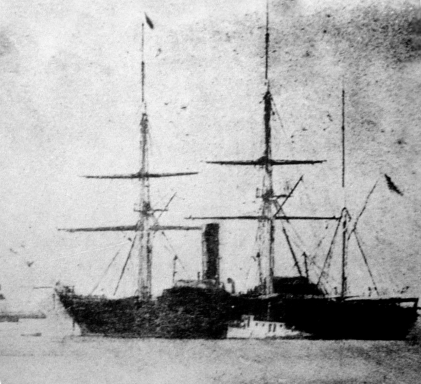
Susquehanna, the Black Ship that Sawamura visited
THE PURLOINED LETTER
The two pages Sawamura obtained from the Susquehanna are written not in English but rather in Dutchunsurprising, as Dutch (along with Portuguese) was a lingua franca between the West and Japan during its period of isolation from the outside world. In fact, the Sawamura family retains the papers to this day. According to the Iga-Ryu Ninja Museum, the content is more banal than strategic: one page consists of the phrase Still waters run deep. The other muses on the perfection of British ladies in bed, French in the kitchen, and Dutch in housekeeping. One can only speculate that this information came in handy on the nations first official diplomatic mission to Europe several years later.
NINJA GONE BAD
1746 A.D.
Name: NIPPON ZAEMON
BirthDeath: 1719-1747
Occupation: Gizoku (Honorable Thief)
Cause of Death: Execution
A.K.A.: Hamashima Shobei (birth name)
Chikushi (Haiku pen name)
Nippon Daemon (in Kabuki)
Preferred Technique: Swordsmanship
Hobbies: Composing Haiku
Gang Affiliation: The Shiranami Five
Existence: Confirmed
The Man
This natural-born swordsman who preferred a life of crime to that of a martial artist dubbed himself Nippon Zaemonessentially, Mister Japan. Operating out of what is now Shizuoka prefecture, he and his gang terrorized a wide swath of the countryside west of Edo. As fond of sticking it to the Man as he was of the stick-up itself, Zaemons penchant for shaking down the rich while steadfastly refusing to physically harm any of his victims made him a folk hero (think John Dillinger with a katana instead of a Tommy gun).
Like Dillinger, his notoriety quickly earned him public enemy status and the questionable honor of being the subject of Japans very first wanted poster, which only helped cement his rep as a bad-ass with a heart of gold. While he wasnt a true ninja, he and his pals took a big page from the ninja playbook.
He targeted the upper crust: successful farmers, merchants, heirs and heiresses, and those transporting money on their behalf. Its officially confirmed that he stole some 2,622 ryo of gold (2.2 million US dollars in modern currency) over the course of his career, an absolutely astounding sum of money at the time.
It helped that Nippon Zaemon surrounded himself with the criminal elite. His right-hand man Nakamura Sazen, a talented strategist and a dandy to boot, actually managed to secure a job with the imperial family in Kyoto. He used his position to send Nippon Zaemon official lanterns marked with the royal crest, the Edo-period equivalent of a secret-service badge and a virtual free pass to anywhere in the country.
The Moments of Glory
Not one to lurk in shadows, Nippon Zaemon pounced on his victims in broad daylight, dressed to the nines. He would begin with a bold declaration of whom they were having the honor of being robbed by, and depart with a promise that everything stolen would be used to help the poor. Word of his antics struck a chord with the other half, who conveniently ignored the fact that he never seems to have actually distributed any of this ill-gotten wealth to the needy. (This probably says more about class relations at the time than it does about any actual belief in him as Japans answer to Robin Hood.)
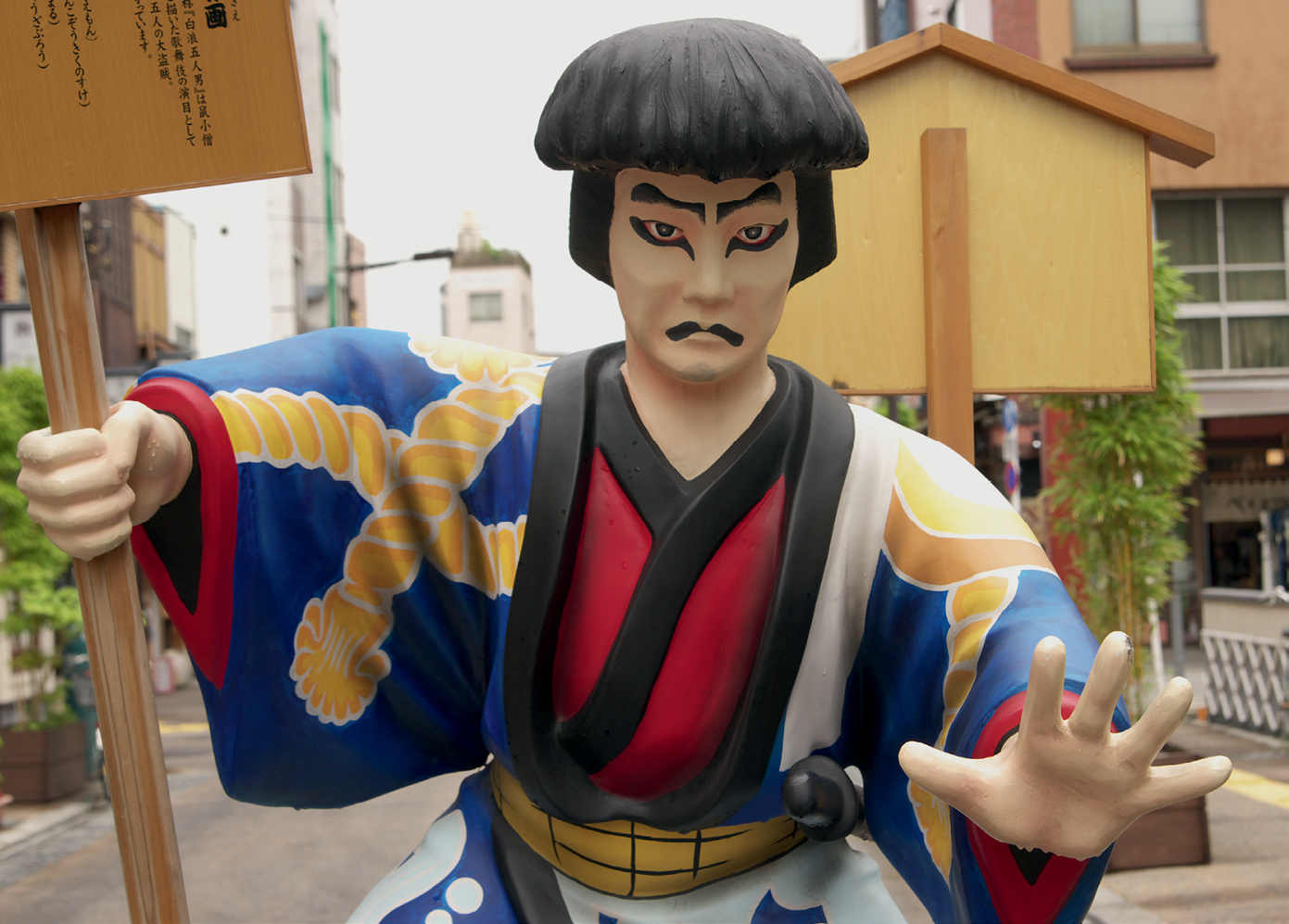
A statue of Kabuki hero Nippon Daemon in Asakusa, Tokyo
Only two crimes truly warranted the full attention of the authorities in the hierarchy-obsessed Edo period: murdering ones parents or murdering ones master. Nippon Zaemon changed all that. Fed up with the local enforcers inability to tame Mister Japan and his merry men, the shogunate released a detailed wanted poster, complete with a police sketch of his appearance in 1746. It was a first in Japan.
Shaken by the sight of the poster, Nippon Zaemon went into hiding. Dropping out of his criminal network, he began staying at the homes of friends he had made, penning and exchanging haiku verse of the sort popularized by Matsuo Basho. And rather than going underground, he hid in plain sight, touring the many countryside haiku roads (tourist paths that led to scenery conducive for producing poems).
The End
On January 7, 1747, Nippon Zaemon surrendered himself to the authorities in Kyoto, and on March 11th, he was executed, his head displayed on a garrote for all to see. But his legend lived on. In 1862, more than a century after his death, a kabuki play starring a character based on Nippon Zaemon as the leader of a gang of five super-bandits called the Shiranami Five opened to raves. (Pop-cultural historians cite the play as the direct historical ancestor of the Power Ranger style kids show so popular in Japan and abroad today.)
Next pageFont size:
Interval:
Bookmark:
Similar books «Ninja Attack!: True Tales of Assassins, Samurai, and Outlaws»
Look at similar books to Ninja Attack!: True Tales of Assassins, Samurai, and Outlaws. We have selected literature similar in name and meaning in the hope of providing readers with more options to find new, interesting, not yet read works.
Discussion, reviews of the book Ninja Attack!: True Tales of Assassins, Samurai, and Outlaws and just readers' own opinions. Leave your comments, write what you think about the work, its meaning or the main characters. Specify what exactly you liked and what you didn't like, and why you think so.




